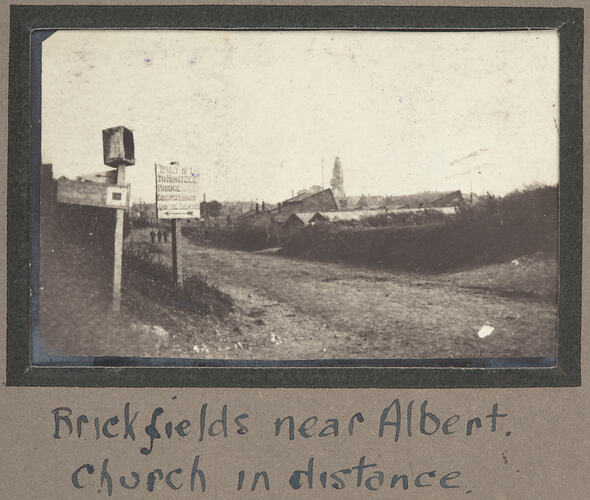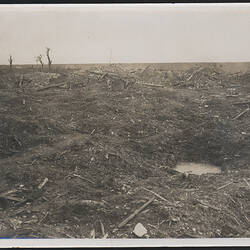Summary
Black and white photographic print which shows the 'Brickfields' near Albert and the Basilica of Notre-Dame de Brebières standing in the distance. The Brickfields, an old brick factory on the outskirts of Albert, was used as a large billeting area by Allied troops. It was best described as a bare and uninviting place. Its close proximity to Albert and the frontline made it an ideal position for soldiers to stay in makeshift shelters for short periods of time.
It is one of 95 black and white, and, sepia toned photographs taken in France during World War I, attached to a photograph album. The album includes a few photographs of enemy prisoners, the war cemetery at Warloy, a wrecked German ambulance and images of the local French people.
Most photographs are of Albert and surrounds so it would seem probable that most were taken during and after the Battle of the Somme (1916). In addition there are also photographs dated 1917. The photographs were taken by Private John Edward Lord, 13th Field Ambulance, and brought back to Australia by him and compiled in an album at the end of the First World War.
The album is one of many souvenirs brought back to Australia after World War I by Lord, and is part of a larger collection of photograph albums, images, documents and World War I memorabilia donated by Lord to Museum Victoria.
Description of Content
The image shows a dirt road that appears to lead into a township. There is a sign in the foreground that states: 'Road No. 1 To Howitzer Bridge / Crucifix Corner and the Trenches'. Just beyond the sign a group of three men can be seen walking down the road. Along the roadside in the background groups of houses are visible stretching into the distance. In the very background the steeple of the Basilica of Notre-Dame de Brebières can be seen.
Physical Description
Monochrome photograph, mounted in a small, grey photograph album.
Significance
This album appears to have been prepared to 'showcase' the war experiences of John Lord and the photographs associated with these. The album has been very carefully prepared and the quality of the photographs is generally good, in comparison to the album ST40491, also compiled by John Lord, which has a number of photographs which are of poor quality, many photographs removed and written in (mostly) illegible pencil. This suggests this album was most probably compiled after the war, with photographs probably gathered from other photograph albums of Lord's.
The subjects of the photographs are of trenches (both German and Allies), horses, camps, farms, graves and cemeteries, civilians, soldiers, churches and other buildings. Many of the photographs were taken around the town of Albert and are dated 1916 and 1917. From this information we can tell that Lord was involved with the Battle of the Somme when these photographs were taken.
The Battle of the Somme was fought from north of the Somme river between the towns of Albert and Arras. The Battle began on the 1 July and was called off on the 18 November 1916. The Battle of the Somme is famous for the loss of 58,000 British troops (one third of them killed) on the first day of the battle, 1 July 1916, which to this day remains a one-day record.
More Information
-
Collection Names
-
Collecting Areas
-
Acquisition Information
Donation from J. Lord, 1986
-
Place & Date Depicted
-
Photographer
Sergeant John Lord, Albert, France, 1916-1917
Image may have been taken by Lord or collected by him for use in this album. -
Format
Photograph, Monochrome
-
Inscriptions
Hand written in ink on matt directly below the photograph: 'Brickfields near Albert. / Church in distance.'
-
Classification
-
Category
-
Discipline
-
Type of item
-
Image Dimensions - Photograph
66 mm (Width), 44 mm (Height)
-
Image Dimensions - Photograph album page
192 mm (Width), 146 mm (Height)
-
Keywords
Australian Army, Militaria: Australian, Military Memorabilia, Souvenirs, Wars & Conflicts, World War I, 1914-1918, Battle of the Somme (Somme Offensive), 1916


